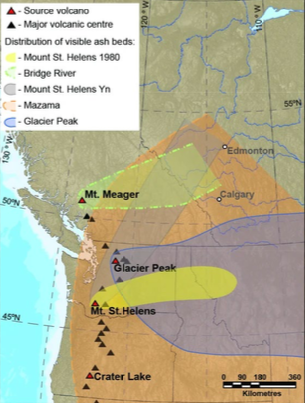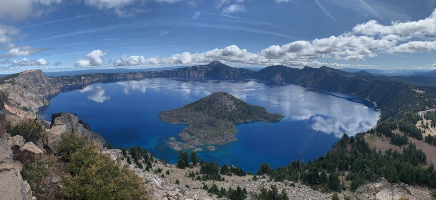Volcano
What is a Volcano?
A volcano is “a vent in the surface of the Earth through which magma and associated gases and ash erupt; also, the form or structure, usually conical, that is produced by the ejected material.”
Magma Sources and Types
-
Recall: lava is magma (i.e., molten rock) that flows on the earth’s surface
-
Temperature should be high enough and pressure low enough to melt rock
- Most magma originates in upper mantle (50-250 km deep in Earth)
-
Most volcanoes found in one of these 3 settings:
- Divergent boundary – oceanic and continental
- Convergent boundary – above subduction zones
- Hot spots (i.e., not associated with plate boundary)
-
Magma composition and physical properties dictate how the volcano erupts
-
Composition determined by the rock material that is melted and extent of melting
-
Raw materials and melting processes controlled by the tectonic setting

See Magma
Styles (and Locations) of Volcanic Activity
- Fissure Eruptions
- Hot spots
- Shield Volcanoes
- Cinder Cones and Pyroclastics
- Composite Volcanoes
Fissure Eruptions
-
Eruption of magma from a crack in the lithosphere
-
Continental examples are often huge in area
- E.g., Columbia Plateau of USA
- E.g., in India and Brazil
- Mostly dormant/extinct

-
Also, in oceans at spreading centers
-
~70 000 km of submerged magmatic fissures
-
Most volcanic (igneous) rock formed at spreading centers
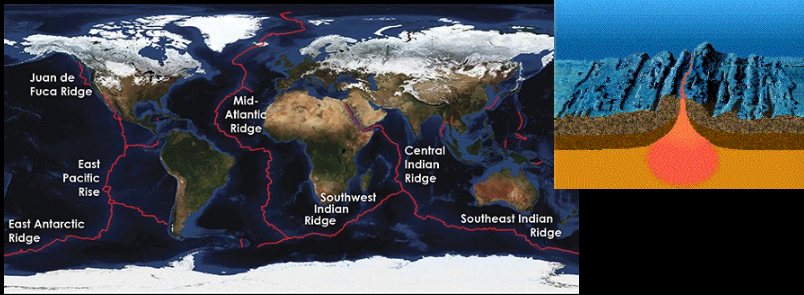
Hot Spots
-
In the middle of a plate, but not clear on why they occur
-
Could be heat from core/mantle boundary or radioactive hot spots Examples include
-
Hawaiian Islands
-
Galapagos Islands
-
Yellowstone National Park, USA

-
Majority of volcanoes we are familiar with lie along plate boundaries
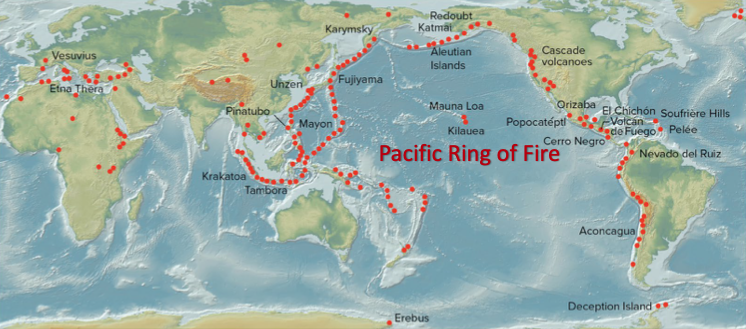
Shield Volcanoes
- Mafic lavas (low viscosity) flow easily and far; Not typically eruptive
- Many long and steady lava flows create a broad, shieldlike shape – large area and relatively flat volcanoes
- E.g., Hawaiian Islands

- E.g., Hawaiian Islands
Cinder Cones and Pyroclastics
- Cinder cones formed by lava that cools into a solid while being ejected ⇒ pyroclastics (bits of erupted volcanic material)
- Eruptions happen because of gases trapped in the lava (more likely from thick felsic lava)
- Cinder cones: Small area; larger height relative to area; fairlly symmetrical
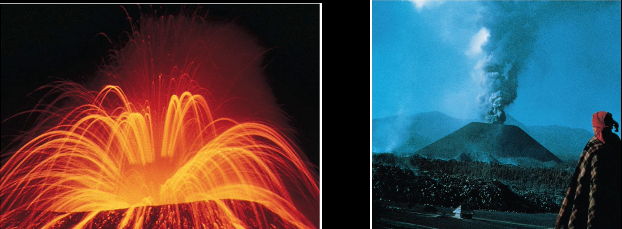
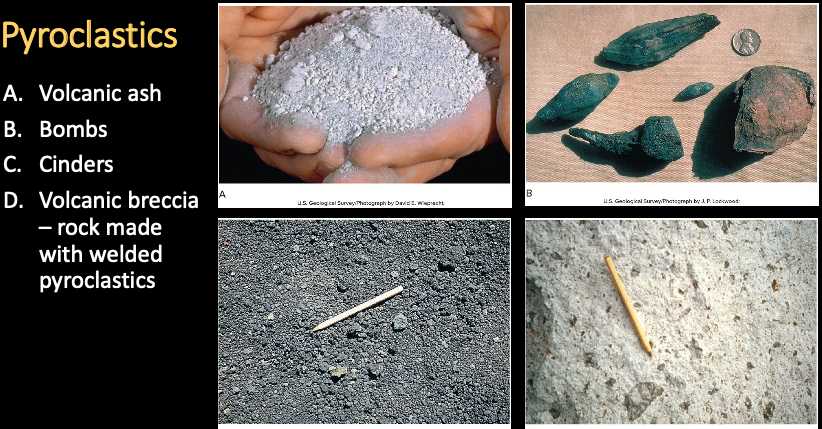
Composite Volcanoes
- Built by multiple layers of material (lava flows and pyroclastics)
- Intermediate type lavas that can flow and trap gas
- World’s most dangerous volcanoes are of this kind
- Larger than cinder cones but smaller than shield
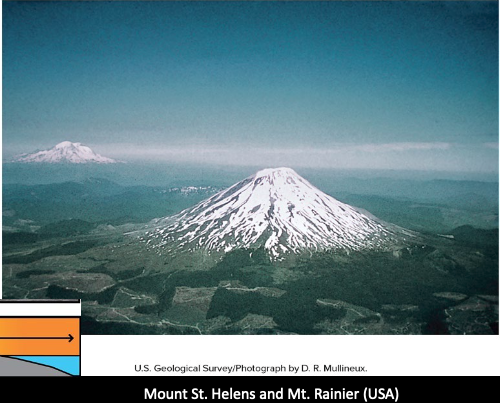


- Lava domes formed from slow-flowing rhyolitic (or andesitic) lavas oozing out of vent and staying close by to cool
- Often formed in statovolcano craters after eruption
- Indicative of explosions and possibility for more
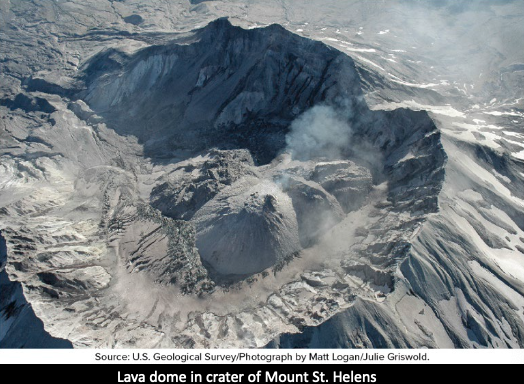
Hazards related to volcanoes and prevention
- Lava
- Pyroclastics
- Pyroclastic flow
- Lahards
- Toxic gases
- Steam explosions
- Landslides / Collapse
- Secondary effects
Lava
- Not most dangerous to life ⇒ slow moving (< few km/h)
- But is to property ⇒ hot (>850 ) so cause fire, melting or turns to rock
- Prevention: Don’t build near, but often fertile land
- Prevention: Cool down the lava - Heimaey, Iceland, 1973
- Prevention: Explosives to divert lava flow - Mt. Etna, Italy, 1983; Hawaii, 1935
Pyroclasitcs
- Sudden, explosive eruptions that ca spread fast and far
- Range of sizes: Large drop closer to vent; Ash can go 100 - 1000s km
- Recall more felsic lavas are thicker and have more trapped gases

Major hazards due to pyroclastics:
- Reduction in air quality
- Burying of structures
- Disruption to air travel
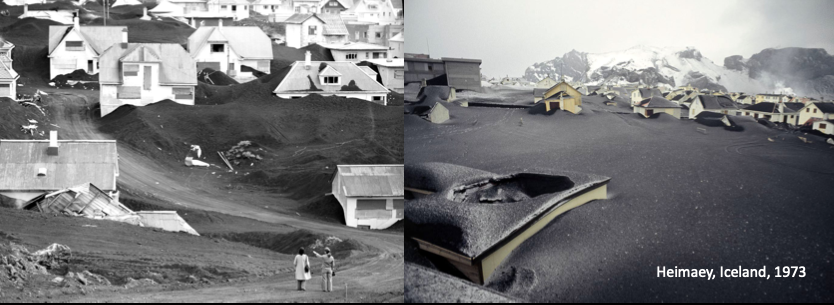
Pyroclastic Flows
- Mixture of hot gases and fine ash that is much denser than air, very hot (>1000°C), and flows very fast down slopes (>100 kph)
- How it forms: Above volcano hot gas lifts ash and magma droplets to mix with the air to form a cloud
- When too dense the cloud collapses and flows down the slope
- Can also form within in a crater and spill over the sides and down slope
- Prevention: Not be in its path! If volcano is mildly erupting and has slightest possibility of a pyroclastic flow, then leave.
Mont Pelée, Martinique, 1902
- Had been erupting for weeks but not posing danger
- May 8, 1902 – pyroclastic flow leveled the town of St.Pierre and killed up to 40,000 people
- Sole survivor was prisoner in a dungeon jail
Lahars
- Ash and water combine to create a fast-moving (sometimes hot) volcanic mudflow that clogs rivers and destroys much in its path
- Source of water: rain or glacier / snow melt
- Mount Pinatubo, Philippines, 1991
- Flooding may be more common after the lahar as rivers / streams remain clogged.

Toxic Gases
- Water vapor and Carbon dioxide - largerst by volume; not toxic; CO2 can suffocate animals, plants, people
- Carbon monoxide, various sulfur gases, hydrochloric acid, fluorine - poisonous
- Released directly or from magma chambers into lakes, soils, basements
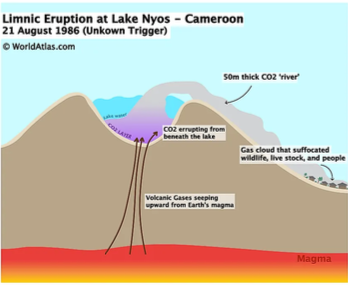
Steam Explosions
-
Phreatic eruption – large quantities of water (usually seawater) seep down through rock near to hot magma which turns water into steam and boils up out of a volcano
-
Krakatoa, Indonesia, 1883
-
Force of 100 million tons dynamite
-
Heard 3000 km away
-
Dust 80 km into atmosphere
-
Ash found in area of 750,000 km2
-
Tsunami 40 m high killed 36, 000

Landslides and Collapse
- Volcanoes can become weak and unstable due to weathering
- Result: Landslides or collapses can happen
- Removal of material may lead to an eruption (e.g., Mount St. Helens)
- Seaside collapses/landslides can cause tsuamis (e.g., Mt. Mayuyama, Japan, 1792 killed 15,000 people)
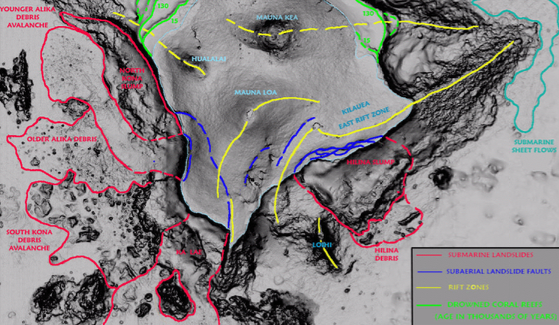 Concern that past slides around island of Hawaii are indicative of more slides to come
Concern that past slides around island of Hawaii are indicative of more slides to come
Secondary effects: Climate and Atmospheric Chemistry
-
Dust in atmosphere from large explosions can last months to years
- Global temperatures dropped by 0.5°C after 1883 Krakatoa eruption
- 1816 ‘year without a summer’ after Tambora (Indonesia) 1815 eruption
-
Sulfuric-rich gases can lead to acid rain
-
Sulfur dioxide (SO2) mist can decrease incoming solar radiation
- Mount Pinatubo, Philippines, 1991 – average global temperature drop of 0.5C
- Mist had spread worldwide, and USA had unusually cold summer in 1992
Issues in Predicting Volcanic Eruptions
- Chaitén (Chile) erupted in 2008 after nothing for 9400 years
- Pyroclastic flows destroyed the village of Chaitén and was not rebuilt
Volcanic Explosivity Index (VEI)
- Characterize relative size of explosive eruption based on
- Volume of pyroclastics
- How high they rose into atmosphere
- Length of eruption
- Useful for predicting future hazards at a given volcano
- Thought it could be used to predict impact on climate, but SO2 is a key factor

Volcanic Eruption Precursors
- Seismic activity due to volcano
- Or earthquake opens fissures of dormant volcanoes
- Harmonic tremors – continuous, rhythmic
- Mechanism not known
- Bulging, tilt, or uplift of volcano surface
- Eruption timing depends on overlying rocks
- Changing mix of gases emitted – SO2 promising
- Remote sensing of surface temperature may reveal rising magma
- Lives have been saved because of precursors (evacuation)
- Evacuated 80,000 people before Mount Pinatubo’s big eruption
Canada’s Volcanoes
-
5 active regions in British Columbia and Yukon
-
49 eruptions during the last 10,000 years
-
Most recent was 150 years ago at Lava Fork, northwestern B.C.
-
Last big explosive eruption was 2350 years ago at Mount Meager (ash later seen in geology)
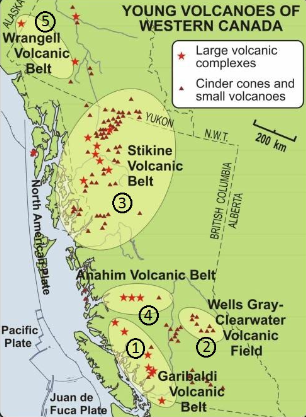
-
Ash layers in Alberta from various volcanic eruptions
-
Tiny pieces of igneous glass and pumice

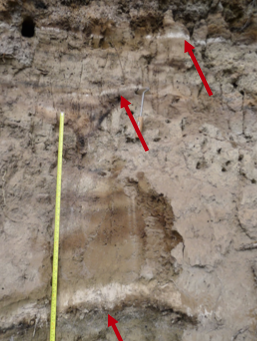
-
Mount Mazama - one of the largest eruptions in the last 10,000 years
-
Destroyed volcano and left behind Crater Lake in Oregon
-
Ash found as far away as Greenland
